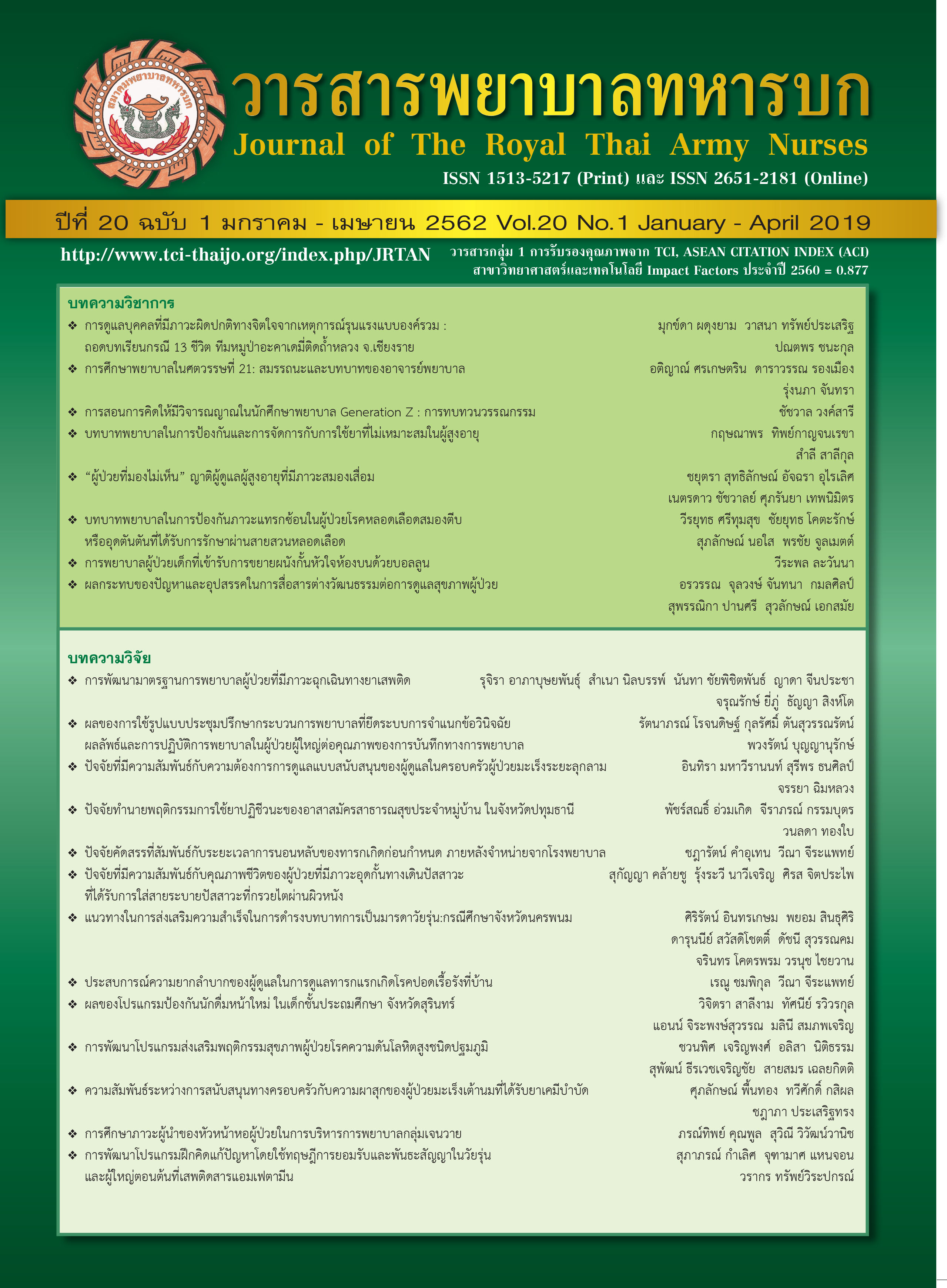Teaching to Critical thinking in Generation Z Nursing Student: A Review of Literature
Keywords:
generation Z, nursing student, critical thinkingAbstract
This article analyses characteristics and outcomes of teaching to critical thinking for generation Z nursing student programs. Using the PICO framework to conduct a search through the Thai Journal Citation Index Centre, ScienceDirect, PubMed, and Google Scholar,the researcher obtained seven experimental studies that met the criteria.
An analysis of these studies led to the following findings; 1) Critical teaching methods have 6 methods include explanation of the course clearly, self-learning, group discussion, presentation of class work with reflection techniques, cresting mild mapping for lesion, and teaching with case studies. 1.1) Time spent in the program of teaching, thinking to have effective judgment starting from 135 minutes or more depending on the lesson content. 1.2) Activities for teaching students to have critical thinking such as VARK Learning Styles, assigned to plan the concept of nursing mapping as a group, discussions and summary issues, learn teaching materials through e- learning etc., all learning activities must focus on the students to take action themselves, and t practice analyzing the simulation. 1.3) t he role of the instructor that gives the learner a critical thinking such as being a controller for the puppet to show signs according to the scenario, is the urge to thinking connection find a reason, is a reflection, and summarizing issues and guiding students to make critical decisions. and 1.4) the role of the learner must participate in the learning activities planned by the instructor and must have continuous thinking according to the program. 2) The results of the program of teaching to think critically based on empirical evidence finding; The critical thinking of students evaluated about critical thinking ability, critical thinking features, critical thinking skills, and critical problem solving ability. 2.1) the results of the thinking teaching program are critical most students after entering the program have a more critical thinking than before entering the program and in the experimental group, the critical thinking was higher than the control group. and 2.2) All program measurements are measured after the end of the trial program. There is no follow-up evaluation.
References
2. Zuriguel Pérez E, Lluch Canut MT, Falco Pegueroles A, Puig Llobet M, Moreno Arroyo C, Roldan Merino J. Critical thinking in nursing: Scoping review of the literature. International journal of nursing practice. 2015;21(6):820-30. (In Thai)
3. Wongsaree C. Clinical in Adult Nursing Practicum Course for Generation Z Collegian. Journal of Boromarajonani College of Nursing, Bangkok.2015;31(2):130-140. (In Thai)
4. Kamkhieo W, Nantakaew N, Kulnitichai W, and Tachawong K. Effects of Concept Mapping on Critical Thinking Ability among Nursing Students of The University of Phayao. Journal of Nursing and Education. 2018; 11(3): 24-35. (In Thai)
5. Khumkom S. Effect of Using Smart Educational Media Creator (SEMC) on Learning Achievement of Nursing Practicum of Mental Health and Psychiatric and Critical Thinking among Nursing Students. Journal of Nursing and Education. 2015; 8(4): 126-139. (In Thai)
6. Yalapa M, Ruengroengkunrit P, Thongchan J, Suwan K, and Chalaweesak K. Effects of Simulation Based Learning to Enhance Critical Thinking of Nursing Students, Boromarajonani College of Nursing Yala. Journal of Nursing, Public Health, and Education. 2017;18 (3): 128-134. (In Thai)
7. Hall HR, Roussel LA. Evidence-based practice: Jones & Bartlett Publishers; 2016.
8. Ackley BJ, Swan B A, Ladwig G, & Tucker S. (2008). Evidence-based nursing care guidelines: Medical-surgical interventions. (p. 7). St. Louis,MO: Mosby Elsevier.
9. Yalapa M, Ruengroengkunrit P, Thongchan J, Suwan K, and Chalaweesak K. Effects of Simulation Based Learning to Enhance Critical Thinking of Nursing Students, Boromarajonani College of Nursing Yala. Journal of Nursing, Public Health, and Education. 2017;18 (3): 128-134. (In Thai)
10. Soowit B, Kamwicha P, and Muksiritipanun B. A Development of the Happiness Learning Instructional Model in Adult Nursing Practicum II for Promoting Learning Happiness and Critical Thinking among Nursing Students, Kuakarun Faculty of Nursing, Navamindradhiraj University. Journal of The Royal Thai Army Nurses. 2014;15(2): 242-251. (In Thai)
11. Sirisom K, Wunnawilai P, Ampansirirat A, Chuencharoen S, Chitviboon A. Effect of Case Studies Combined with Concept Mapping Technique on Critical Thinking of Nursing Students. The Journal of Nursing Science. Sup.1, 2015; 33(1): s18-s26. (In Thai)
12. Leeyutthanont M, Chindanuruk T, Thammapreteep J, Leuboonthavatchai O. The Development of Evidence-based Nursing Practice Instructional Model for Critical Problem Solving. Princess of Naradhiwas University Journal. 2017; 9(3):83-93. (In Thai)
Downloads
Published
How to Cite
Issue
Section
License
บทความหรือข้อคิดเห็นใดใดที่ปรากฏในวารสารพยาบาลทหารบกเป็นวรรณกรรมของผู้เขียน ซึ่งบรรณาธิการหรือสมาคมพยาบาลทหารบก ไม่จำเป็นต้องเห็นด้วย
บทความที่ได้รับการตีพิมพ์เป็นลิขสิทธิ์ของวารสารพยาบาลทหารบก
The ideas and opinions expressed in the Journal of The Royal Thai Army Nurses are those of the authors and not necessarily those
of the editor or Royal Thai Army Nurses Association.





